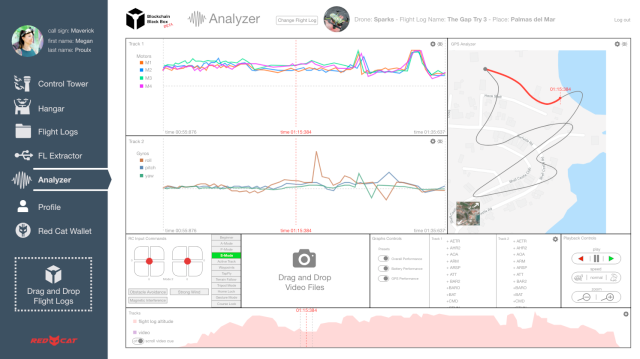Drones are increasingly posing risks to airplanes, in ways both inconvenient and dangerous. Earlier this year, planes flying into Newark Liberty International Airport were halted after pilots reported a drone flying near the airport. Last December, a drone hit a Boeing 737 that was landing in Tijuana, Mexico, causing damage to communications equipment and punching a hole in the outer layer of the airplane’s nose. According to the Federal Aviation Administration, pilots are seeing drones more often, including 2000 times in 2018, up by 74 percent from 2017.
Get the BREAKERMAG newsletter, a weekly roundup of blockchain business and culture.
Drones are also hard to track. They don’t usually show up on a plane’s radar and the only thing limiting where they can fly is their battery range. But Red Cat, a company working to secure airspace globally for the drone industry, is building black boxes for drones that will track essential data, including flight paths, using blockchain. The company recently announced the second beta of its drone data platform, used to store flight data on blockchain. Red Cat is testing the platform on both GoChain and EOS blockchains.
Data analysis in Red Cat's platform

In planes, black boxes record important flight data, as well as communications coming from the plane’s cockpit. Such information is key when a plane goes down. It helps investigators determine what happened, and examine mechanical failures. But no such parallel for drones existed.
“We can give you every bit of information about how your drone was performing on that entire flight, not only just for if you crash, but also information such as why this drone uses more battery than this drone, even though they’re almost identical,” says Jeff Thompson, CEO and founder of Red Cat.
This has implications not just for drone performance, but also for insurance companies, who need to be able to see how drones are performing, their flight paths, and who owns them in order to insure them. The insurance market around drones is growing and could be worth more than $500 million in the U.S. and $1 billion globally by 2020, according to Allianz. Amazon, for example, is expanding its fleet of drones for delivering packages. Liability has to be taken into account in case one of these drones malfunctions and goes through someone’s window, or hits a person. By utilizing blockchain technology, Red Cat says they can document data that insurance companies can rely on as accurate, without the need to trust a central authority.
Flight logs in Red Cat's platform

The data can also help prevent drones from flying into airplanes. Red Cat uses ADS-B transponders, which all planes are equipped with. The system determines the plane’s position, triangulated by satellites, and then broadcasts that position, enabling the plane to be tracked. Imagine it a digital game of Marco Polo, where you know where someone is even though you can’t see them, because they’re yelling “polo”.
“[The transponders give] us the ability to put drones on the radar screens inside of the cockpits of all aircraft and create what we call drone shields,” says Bryan Larkin, Red Cat’s CTO. “The drone shield we’ve created essentially creates a bubble around all aircraft.” The ABS-D transponder system works with the flight controller (basically the hardware brains of the drone) so that when it gets the location of an aircraft, it’s not allowed to get within a certain radius of it.
Drones are only likely to grow in number, so addressing these sorts of issues is key to building a sustainable industry. “If we can make it so that it’s reliable data out there, the insurance can become smarter, your liability can come become better, and everyone can be making better informed decisions,” says Thompson. “So as a drone fleet owner, you know that your data is trusted, and utilizing blockchain to do that, I’d say, is the only way to do it.”